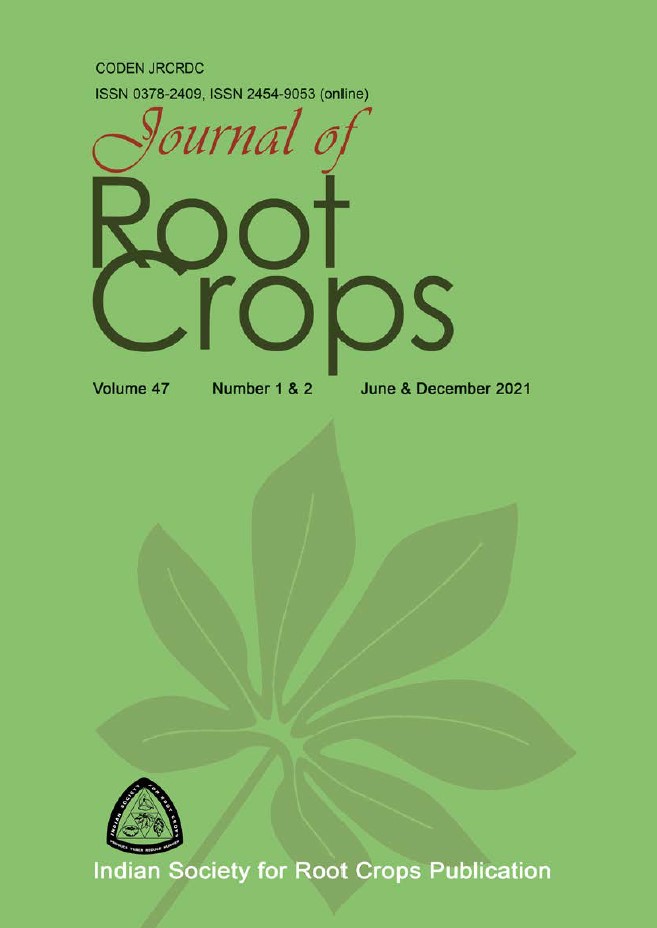Impact of fluctuating actinic high light stress on biomass and yield of cassava
Abstract
Cassava (Manihot esculenta Crantz) is a staple crop grown in the tropics for food as a major calorie source as well as in industrial use. In natural environment, crops undergo rapidly changing light conditions which affects the photosynthetic efficiency. When exposed to excess photon flux densities, plants under go non photochemical quenching (NPQ) by which the excess energy is harmlessly dissipated as heat in order to protect the plants from photo-damage. Upon the transition to low or optimal light for photosynthesis, the slow rate of recovery of NPQ can limit effective photosynthetic efficiency which consequently results in low crop productivity. In the present study, the physiological and fluorescence responses of six field grown cassava genotypes to intermittent high red actinic light (IHL) were examined and compared against control plants grew under ambient light conditions. From the results, it was seen that overall average values of plant height and fresh above ground biomass (ABM) was higher under IHL conditions (206.6±26.5 cm and 2.34±0.67 Kg respectively), while high crop biomass (CBM) was observed in control condition (3.11±0.86 Kg). It was found that Sree Suvarna had the maximum CBM under both the control and IHL conditions (4.31±0.32 Kg and 4.11±0.44 Kg respectively). Higher average values of Pn measured was 34.04±1.6 ?molm-2s-1 (Control - Sree Suvarna), NPQ was 2.12±0.36 (IHL - Sree Athulya) and qN was 0.85±0.03 (Control - Sree Pavithra). Significant difference in fluorescence parameters and crop yield were observed between the light conditions and also between the cassava varieties. It was inferred that IHL has obviously affected the NPQ induction/relaxation process which resulted in reduced CBM compared to that under control condition.Downloads
Published
How to Cite
Issue
Section
License
Dear Author(s)
We need your written permission before we can publish your accepted article in the Journal of Root Crops. Please read this form carefully, complete it and palace your signature below. A scanned copy of this form may be mailed to us within two days of receipt of this letter. Our email ID is: isrc_ctcri@yahoo.com or editor_jrc@yahoo.com or sreekumarctcri@gmail.com
Details:
In consideration of the publication in the Journal of Root Crops of our contribution entitled
(Name of the paper): .................................................................................................................
.................................................................................................................................................... by us (all Authors’ names) ..........................................................................................................
....................................................................................................................................................
A. To be filled in if copyright belongs to you
I/we hereby assign to Indian Society for Root Crops, Thiruvananthapuram, India, the full copyright in all forms and media in the said contribution, including open/ restricted access to online version. They own the rights to freely grant or distribute the paper to any third party or public
Please tick this box if you are the sole author of the paper
Please tick this box if you are authorised to execute this copyright transfer on behalf of all the authors of the above article
Name (block letters): . . . . . . . . . . . . . . . . . . . . . . . . . . . . . . . . . . . . . . .......
Institution/Company:..................................................................................................................
....................................................................................................................................................
Signature:.....................................................................; Date: ....................................................
B. To be filled in if copyright does not belong to you
1. Name and address of copyright holder:................................................................................
........................................................................................................................................................................................................................................................................................................
2. The copyright holder hereby grants Indian Society for Root Crops, Thiruvananthapuram, India the full copyright in all forms and media in the said contribution, including open/ restricted access to online version. They own the rights to freely grant or distribute the paper to any third party or public.
(Signature of copyright holder or authorised agent)





